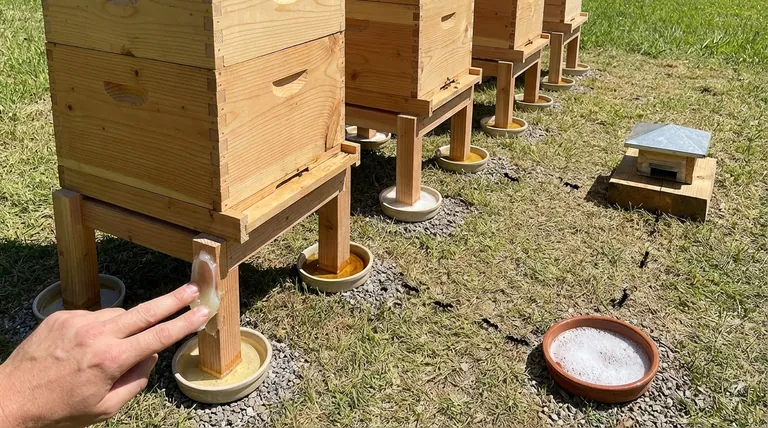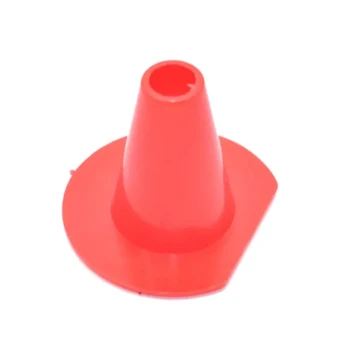The most effective methods for getting rid of ants in beehives involve a combination of creating physical barriers, maintaining a clean apiary, and, when necessary, using strategic, bee-safe baits away from the hive itself. The primary goal is to make the hive inaccessible and unattractive to ants without introducing substances that could harm your honeybee colony.
The core principle is not just to kill the ants you see, but to create a defensible fortress for your bees. A successful strategy focuses on prevention and isolation, ensuring the health of the colony remains the top priority.

The Foundational Strategy: Prevention and Barriers
The most reliable way to manage ants is to stop them from ever reaching the hive. This involves creating physical obstacles that ants cannot cross.
Elevate and Isolate the Hive
A hive stand is your single most important tool. By raising the hive off the ground, you dramatically reduce the number of ways ants can gain access, forcing them onto the stand's legs.
Create an Impassable Moat
This is a classic and highly effective technique. Place each leg of your hive stand into a small dish or can filled with soapy water or oil. Ants cannot cross this liquid barrier, effectively cutting off their primary invasion route.
Apply Slippery Barriers
For an alternative to a moat, you can coat the legs of the hive stand with a thick layer of a slippery, non-toxic substance like Vaseline. Ants are unable to get a grip on the slick surface and cannot climb into the hive.
Eliminate "Ant Bridges"
You must maintain the area around your hive. Trim any grass, weeds, or overhanging tree branches that touch the hive, as ants will use these as bridges to bypass your stand's defenses.
Active Management and Removal
If ants have already found their way to your hive, you must combine barrier tactics with active removal and sanitation.
Conduct Regular Hive Inspections
Check your hive bodies and lids for any cracks or holes that could serve as entry points. Seal these openings immediately to deny ants easy access.
Maintain Apiary Sanitation
Ants are drawn to food sources. Be meticulous about cleaning up any spilled honey, sugar syrup, or dropped pieces of honeycomb around the apiary. A clean environment is less attractive to pests.
Use Bee-Safe Baits Strategically
If you have a persistent ant problem, use a natural or bee-friendly ant bait. Crucially, place these baits along ant trails away from the hive entrance, never inside it. This targets the ant colony at its source without endangering your bees.
Understanding the Pitfalls and Dangers
Your primary duty is to protect your bees. Many common pest control methods are catastrophic for a honeybee colony.
The Extreme Risk of Chemical Contamination
Never use standard insecticidal sprays or powders on or near your beehive. These chemicals are highly toxic to bees and can quickly wipe out an entire colony or contaminate your honey.
Why In-Hive Treatments Are a Mistake
Placing any ant bait or poison inside the hive is incredibly risky. You risk killing your bees, contaminating the honey and wax, and potentially harming the queen or brood.
The Importance of Placement
Even bee-safe solutions must be used correctly. The goal is to intercept ants, not to lure them toward the hive. Always place baits and traps along ant pathways, leading them away from your bees.
Making the Right Choice for Your Goal
Your approach should match the severity of the ant pressure you are facing.
- If your primary focus is setting up a new hive: Start with prevention by placing it on a hive stand with a moat or other leg barrier from day one.
- If your primary focus is dealing with a minor ant trail: Re-establish your barriers by refreshing your moat or slippery coating and meticulously clearing all vegetation bridges.
- If your primary focus is eliminating a heavy infestation: Combine a robust barrier system with the strategic placement of bee-safe ant baits away from the hive to target the source of the problem.
Ultimately, protecting your colony requires creating an environment where it is simply too difficult for ants to succeed.
Summary Table:
| Method | Description | Key Benefit |
|---|---|---|
| Hive Stand with Moat | Place hive legs in dishes of soapy water or oil. | Creates an impassable physical barrier for ants. |
| Slippery Barriers | Coat stand legs with a substance like Vaseline. | Prevents ants from climbing up to the hive. |
| Apiary Sanitation | Clean up spilled honey/syrup and trim vegetation. | Removes food sources and ant bridges to the hive. |
| Strategic Baiting | Use bee-safe ant baits away from the hive entrance. | Targets the ant colony at its source, safely. |
Protect Your Investment and Ensure Colony Health
Ant infestations can weaken your bees and impact honey production. HONESTBEE supplies commercial apiaries and beekeeping equipment distributors with the durable, wholesale-focused supplies needed to implement these effective ant defenses.
From robust hive stands to essential maintenance tools, we provide the equipment for a pest-free apiary.
Contact HONESTBEE today to discuss your wholesale needs and fortify your hives against pests.
Visual Guide

Related Products
- Wholesales Dadant Size Wooden Bee Hives for Beekeeping
- HONESTBEE Advanced Ergonomic Stainless Steel Hive Tool for Beekeeping
- Beehive Entrance Discs Plastic Bee Entrance Disc for Bee Hives
- Heavy-Duty Stainless Steel Clip-On Frame Perch
- Professional Insulated Winter Hive Wrap for Beekeeping
People Also Ask
- Why were wooden hives traditionally preferred? For Natural Beekeeping Aligned with Bee Biology
- What is the best place to keep bees? Find the Perfect Apiary Site for Your Hives
- What are the essential pieces of equipment for most beekeepers? Get Started with the Right Gear
- What should beginners consider when purchasing beekeeping equipment? A Guide to Essential Starter Gear
- What are the advantages of wooden bee hives? Superior Bee Health & Beekeeper Flexibility



















